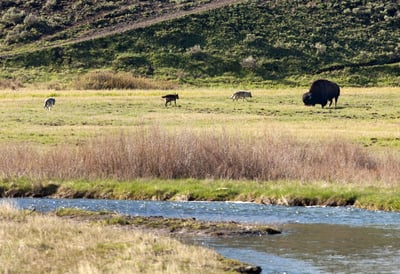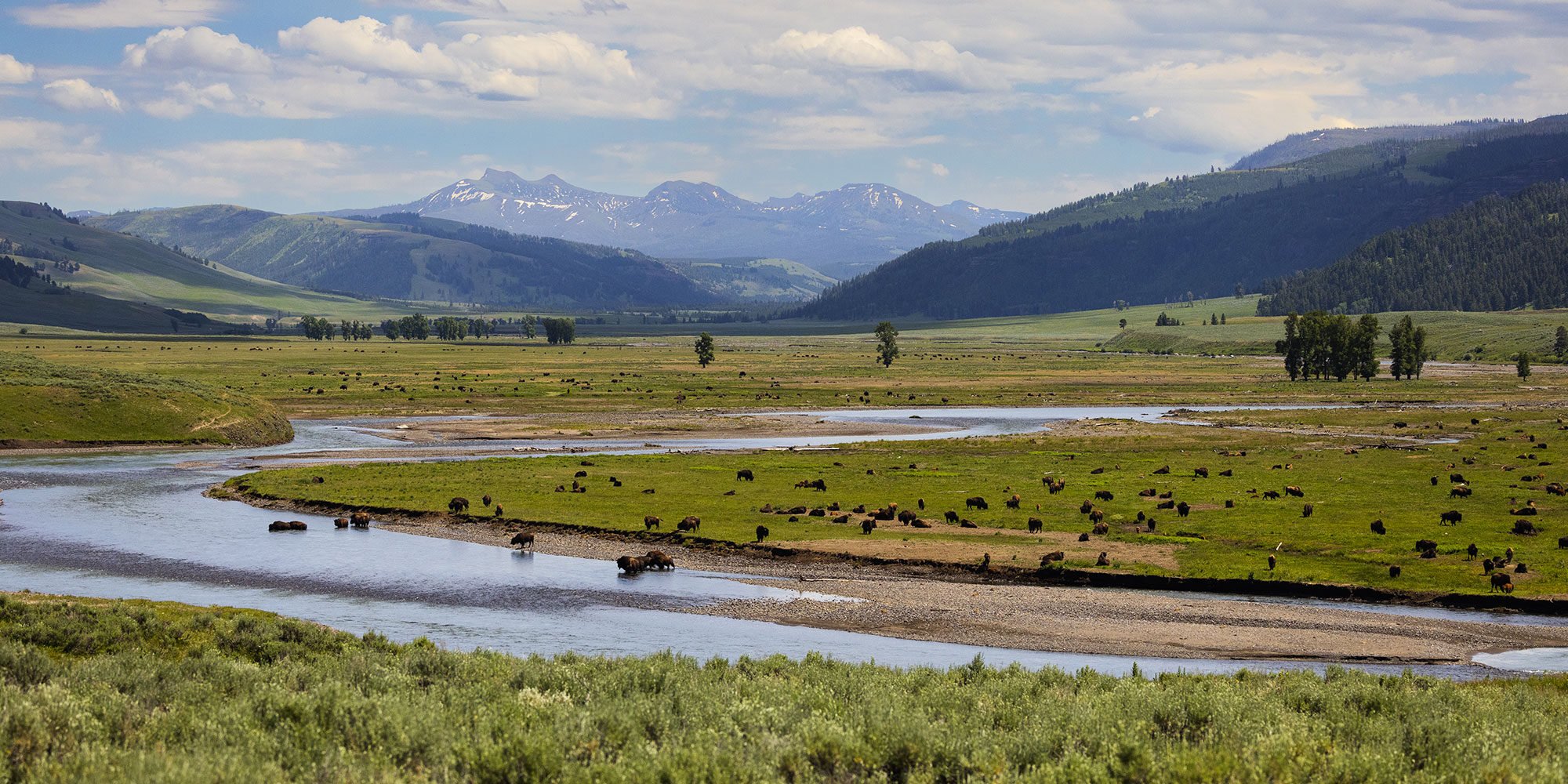Top 10 Things to Do in Yellowstone
The reservations are booked, your bags are packed, and you can't wait to experience the world's first National Park. So what are you going to do when you get there?
Yellowstone is big, and you could spend a lot of time spent driving from one attraction to the next. It's good to have a game plan for the big items you want to see and experience. Plus, if you are coming during June, July or August, you will be joined by a few million other people, all trying to get a view of the American West.
To help you out, we've put together a list of the top 10 things to do in Yellowstone, in no particular order. So pull up a chair and get ready to plan your Yellowstone adventure!
Planning a trip to Yellowstone? Download our free Travel Guide for tips on where to stay, how to get around, and events to attend while you're in town!
The Best Things to Do in Yellowstone National Park
#1: Experience Old Faithful
![]() A list of the top things to do in Yellowstone wouldn't be complete without visiting the world famous Old Faithful. The geyser gets its name because it erupts approximately every 90 minutes. Eruption intervals can range from 60-110 minutes, so it's worth it to arrive early, especially to get a good seat.
A list of the top things to do in Yellowstone wouldn't be complete without visiting the world famous Old Faithful. The geyser gets its name because it erupts approximately every 90 minutes. Eruption intervals can range from 60-110 minutes, so it's worth it to arrive early, especially to get a good seat.
Old Faithful is one of Yellowstone's most popular geyser locations, and the crowds can get quite large. If you are looking to avoid the crowds, we would advise visiting Old Faithful early in the morning (prior to 9 a.m.) or later in the evening (after 6 p.m.).
#2: See the Grand Prismatic Spring
As the third largest spring in the world, the Grand Prismatic Spring is a thing of otherworldly beauty. It's located in the Midway Geyser Basin, along the Firehole River.
Walk along the boardwalk to get up close and personal, but don't step off the boardwalk. For a view from above, check out the Fairy Falls trail that will take you above the geyser basin and provide one of the best views in Yellowstone.
It's hard to describe the vibrant colors you'll see in the Grand Prismatic Spring until you experience it for yourself. The stunning colors come from different species of heat-loving bacteria that live in the water surrounding the spring.
#3: Check Out the Mud Pots
The mud pots around the Park are a unique thermal feature that you just don't see in many places around the world, making them a great thing to check out in Yellowstone.
A mud pot forms when surface water pools in a depression on the earth's surface. The surface water gets heated by thermal water below, causing the mixture of mud, clay, and water to boil. Hydrogen sulfide gas gives mud pots their distinct odor of rotten eggs.
Check out the Artists' Paint Pots located three miles south of Norris Geyser Basin and the Fountain Paint Pots located between Old Faithful and the Madison Junction.
#4: Visit the Grand Canyon Of the Yellowstone
![]() As one of the most photographed areas in Yellowstone, the Grand Canyon of the Yellowstone is a sight to behold. The massive V-shaped canyon is flanked with yellow walls that inspired the name Yellowstone.
As one of the most photographed areas in Yellowstone, the Grand Canyon of the Yellowstone is a sight to behold. The massive V-shaped canyon is flanked with yellow walls that inspired the name Yellowstone.
At the bottom of the canyon flows the Yellowstone River — the force that created the canyon and the longest undammed river in the continental United States. There are numerous viewing points around the canyon, each providing a different perspective of the Upper and Lower Falls. Keep an eye out for birds of prey that nest around the spires and rock formations.
#5: Spot a Bear
 The Greater Yellowstone Ecosystem is home to more than 965 grizzly bears as well as a healthy population of black bears. Spotting a bear is one of the most popular things to do in Yellowstone, but be careful around bears — these are wild animals so please stay at least 100 yards away unless you are safely in your vehicle as they move by.
The Greater Yellowstone Ecosystem is home to more than 965 grizzly bears as well as a healthy population of black bears. Spotting a bear is one of the most popular things to do in Yellowstone, but be careful around bears — these are wild animals so please stay at least 100 yards away unless you are safely in your vehicle as they move by.
The Greater Yellowstone Ecosystem and northwest Montana are one of the few areas in the United States that still have grizzly bear populations. Visiting Yellowstone provides an opportunity to see these magnificent creatures that you really can't get anywhere else in the country.
Seeing a bear in the Park isn't a guarantee, as bears are leery of humans and roadways, but sightings aren't uncommon. Bring a good pair of binoculars to scan the hillsides and valleys throughout the Park.
Download the Bozeman/Yellowstone Travel Guide
#6: See the Bison
![]() The North American Bison is a symbol of the American West. Once estimated at 20-30 million, bison populations used to extend from the Appalachian Mountains to the Rocky Mountains and from the Gulf of Mexico to Alaska.
The North American Bison is a symbol of the American West. Once estimated at 20-30 million, bison populations used to extend from the Appalachian Mountains to the Rocky Mountains and from the Gulf of Mexico to Alaska.
During American westward expansion, bison populations decreased by the loss of habitat and unregulated hunting. Yellowstone is the only place left in the country where bison have lived continuously and have not been hybridized by interbreeding with cattle.
The Yellowstone herd is estimated at over 4,800 bison, giving visitors a good chance to spot a one in the Park. They may appear like friendly, fluffy animals, but they are still wild and can exhibit unpredictable behaviors. More people are injured in the Park each year by bison than any other animal. Bison frequently charge visitors who don't adhere to the 25-yard safe viewing distance. So enjoy viewing these large animals, but keep your distance.
#7: Hike Yellowstone's Trails
![]() There's no shortage of hiking opportunities in Yellowstone National Park. Whether you're looking for a casual stroll along Yellowstone Lake or an intense backpacking adventure, you can definitely find your perfect hike.
There's no shortage of hiking opportunities in Yellowstone National Park. Whether you're looking for a casual stroll along Yellowstone Lake or an intense backpacking adventure, you can definitely find your perfect hike.
The Park has even organized a Yellowstone hiking guide that groups hikes based on their location. Some of our favorites include Mt. Washburn, Fairy Falls, Yellowstone Lake Overlook, and Hellroaring Creek Trail. Remember to follow responsible hiking practices — always hike with a partner and carry bear spray.
#8: Go Fly Fishing
![]() Fishing regulations in Yellowstone National Park are designed to protect and conserve native fish and habitats. The fishing season begins on the Saturday of Memorial Day weekend and extends through the first Sunday in November.
Fishing regulations in Yellowstone National Park are designed to protect and conserve native fish and habitats. The fishing season begins on the Saturday of Memorial Day weekend and extends through the first Sunday in November.
Fishing licenses can be purchased as three-day, seven-day, or season-long licenses. Kids who are 15 years and younger can fish without a permit as long as an adult supervises them, or they can obtain a free license that is signed by a responsible adult. You can buy your Yellowstone fishing license online or purchase one at many of the fly fishing shops surrounding the Park or at one of the Park Service offices.
All native fish, including cutthroat trout, mountain whitefish, and Arctic grayling are catch-and-release only. Please check the fishing regulations on each river or lake you intend to fish for limits on other species.
Some of the most popular areas for fly fishing are the Firehole River, Madison River, Yellowstone Lake, Slough Creek, and the Lamar River. Yellowstone is filled with smaller creeks and lakes that are also fishable, but it is best to consult Yellowstone Park's newspaper, Backcountry Trip Planner, or rangers at visitor centers and backcountry offices to learn more.
#9: Try Horseback Riding
Nothing makes you feel like you are in the Wild West like a horseback ride through the mountains. People are allowed to bring in their horses into Yellowstone, but they must adhere to all the Park's regulations.
For the average visitor, a guided trip is the way to go. Yellowstone allows licensed outfitters to operate guided day trips and overnight trips through the backcountry. Yellowstone National Park Lodges also offers one to two-hour rides at Tower-Roosevelt Lodge and Canyon Lodge. Each ride varies so be sure to check out the Yellowstone National Park Lodges website for specifics.
#10: Look for Wolves
 Since the reintroduction of wolves to Yellowstone in 1995, wolf watching has been one of the top things to do in Yellowstone.
Since the reintroduction of wolves to Yellowstone in 1995, wolf watching has been one of the top things to do in Yellowstone.
As of January 2024, wolf populations were estimated at 124 wolves in ten packs. Populations generally fluctuate year to year, but their territory has been growing steadily over the years.
Most of the wolf packs occupy the northern half of the Park, with numerous packs calling the northeast quadrant of the Park home. The Lamar and Hayden Valleys are some of the best spots to watch for wolves. You'll often find groups of wolf watchers posted up along the pullouts in these two valleys with big spotting scopes waiting for a glimpse of these majestic animals. The winter months make it a little easier to spot wolves from a distance as their darker coats stand out against the white backdrop of the snow.
If you enjoyed this blog, take a look at some of our other related articles at Bozemancvb.com:
- 3 Scenic Hikes in Yellowstone National Park
- 5 Underrated Sights in Yellowstone National Park
- How to Avoid Crowds in Yellowstone
In our never-ending quest to keep up with all things new in Bozeman, we have been producing content for years and can't possibly update every blog when new businesses open or existing businesses close. Please reference the publish date and do your own due diligence when making plans.

